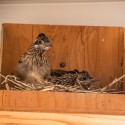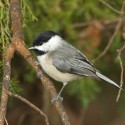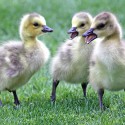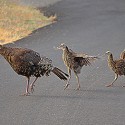 Photo ©
Keith Williams
Photo ©
Keith Williams

Luck Be A Roadrunner
Anneke Moore and her husband Dan have lived in close proximity to roadrunners for about 10 years. Perhaps it was destined that her home would provide shelter for the birds, as the house wasn’t even finished before the roadrunners were checking it out. Anneke told us, “While we were building our house, a roadrunner was already living nearby and came into the house before it was finished. The local workmen here told us this was a sign of good luck.” According to indigenous folklore, one of these birds living near a home brings the residents good fortune.
The southwestern landscape was very different from the lush Pacific Northwest region from which Anneke and Dan had retired 10 years ago. Anneke recalls, “I heard the coo-coo sound from the roadrunner regularly, but did not know where the nest was, or initially, even who made that sound.”
For six years, a bold roadrunner had roosted around their home, first in a nook above their trash cans, then in the horse barn. So Dan made a roosting shelf in the barn, never thinking that it would soon become a “nest shelf.” The roadrunners proved to be industrious nesters, first repurposing a used Curve-billed Thrasher nest, then building another nest in a butterfly bush. More recently, the operation was moved to the roosting shelf in the horse barn, where two broods were raised. The latest brood (pictured) is thought by Anneke to be that of a younger pair. They raised two young.
Roadrunners typically nest in shrubs or cacti, but Anneke’s photos capture a potentially novel situation. Roadrunners can be tolerant of nesting near humans, even as close as your patio table, but can they learn to nest on artificial structures specifically provided for that purpose? Is nesting close to our buildings another way that these clever birds might outwit the wily coyote, or did Anneke and Dan just get lucky? If you want to make your own luck, try putting up a shelf in good roadrunner habitat and tell us what happens!

Way to Go, Chickadees!
NestWatchers just broke the record for number of Carolina Chickadee nests submitted to NestWatch! So far this year, 462 nests have been submitted. The state submitting the most nest attempts, fittingly, is South Carolina.
While still quite common, the Carolina Chickadee has undergone significant population declines in recent years. If you live in the appropriate range and habitat for Carolina Chickadees, you can put up a nest box to encourage nesting. This is one of our focal species, and we are grateful for more data on this species’ nesting success.
Carolina Chickadees are also moving north, and they are nesting in more northern areas now than they were a decade ago. Watch a video describing this northbound move, and if you live in the overlap zone, learn how to distinguish between Carolina and Black-capped Chickadees.

It’s Great to Have Friends
We’re humbled to see that our Facebook page now has more than 10,000 fans. That didn’t just happen; it happened because you shared something that made you think, or smile, or ask. Thank you for your support, photos, and comments, but most of all, thanks for sharing NestWatch with friends.
If you don’t already follow us, please take a moment to see what you’ve been missing. Join our Facebook community today! And for the pinners among you, we’ve also recently joined Pinterest. Share your projects and crafts with us and other NestWatchers.

Happy Turkey Day
The NestWatch office will be closed November 25-28, for Thanksgiving break. We’ll be back Monday, December 1. Please have a happy and safe Thanksgiving holiday!